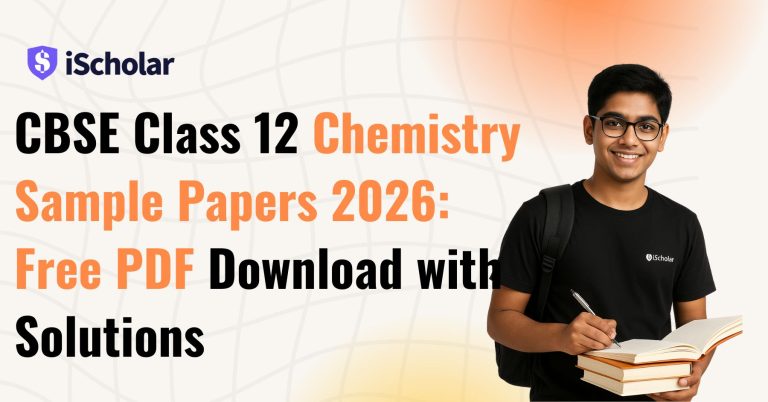CBSE Class 10 Maths 2025-26: Are you preparing for the 2025 – 2026 CBSE Class 10 Maths Board Exam? The first step to success is learning the most recent CBSE Class 10 Mathematics syllabus, regardless of your goals, whether to achieve high results or lay a solid basis for further education. You can study more effectively and efficiently if you comprehend the class 10 maths chapters and their weightings, which cover subjects like quadratic equations, trigonometry, statistics, and more.
A chapter-by-chapter distribution of marks, information on basic and standard math, and a one-click download link for the official CBSE Class 10 Maths Syllabus 2025–26 PDF, Textbooks, and sample paper are all included in this guide. We have everything you need to improve your exam preparation, whether you’re seeking NCERT solutions for Class 10 Maths, practice papers, or past year question papers.
CBSE Class 10 Maths Textbook
NCERT Textbook (Primary Source)
Mathematics – Class 10, published by NCERT, is the official textbook recommended by CBSE.
It covers the entire syllabus and is used to set board exam questions.
Download the CBSE Class 10 Maths Textbook.
CBSE Class 10 Maths Unit-wise Marks Distribution
When you know how marks are distributed, you can make a priority list, making your preparation faster. Here is the mark distribution of each chapter to give you a head start:
| CBSE Class 10 Maths Unit-wise Marks Distribution | ||
| Unit | CBSE CBSE Class 10 Math Chapters | CBSE Class 10 Math Marks Distribution |
| Number System | Real number | 06 |
| Algebra | Polynomials,Linear equations,Quadratic equations,Arithmetic Progression | 20 |
| Coordinate Geometry | Coordinate geometry | 06 |
| Geometry | Triangles,Circles | 15 |
| Trigonometry | Introduction to trigonometry,Trigonometric identities,Height & Distance | 12 |
| Mensuration | Areas related to circles,Surface areas & volumes | 10 |
| Statistics & Probability | Statistics,Probability | 11 |
| TOTAL | 80 | |
Latest CBSE Maths Syllabus 2025-26 Complete Structure
The two parts of the CBSE Class 10 Mathematics Syllabus for 2025 – 2026 are split as follows:
- Section A (Chapters 1 – 8) and
- Section B (Chapters 9 – 14).
A structured approach ensures a well-balanced combination of fundamental concepts and real-world applications. Each chapter is examined below, along with essential subjects and subtopics relevant to the exam.
CBSE Class 10 Maths Part A: Foundational Concepts (Chapters 1- 8)
For more complex mathematics, these chapters provide a foundation. Both the fundamental and standard math syllabi require them.
CBSE Class 10 Maths Chapter 1: Real Numbers
- Fundamental properties of real numbers
- Representation of real numbers on a number line
- Concepts of surds, irrational numbers, and pi (π)
- Euclid’s division algorithm
CBSE Class 10 Maths Chapter 2: Polynomials
- Definition and types: linear, quadratic, cubic polynomials
- Degree of a polynomial
- Arithmetic operations on polynomials: addition, subtraction, multiplication, division
- Factorization and zeros of a polynomial
CBSE Class 10 Maths Chapter 3: Pair of Linear Equations in Two Variables
- Graphical representation and algebraic solutions
- Solving equations using:
- Substitution method
- Elimination method
- Cross-multiplication
- Types of solutions: unique, infinite, and no solution
CBSE Class 10 Maths Chapter 4: Quadratic Equations
- Standard form and nature of roots
- Methods of solving:
- Factoring
- Completing the square
- Quadratic formula
- Discriminant and types of roots (real, equal, irrational, imaginary)
CBSE Class 10 Maths Chapter 5: Arithmetic Progressions
- Definition and basic properties
- Finding the nth term (Tn)
- Sum of the first n terms (Sn)
- Application-based problems
CBSE Class 10 Maths Chapter 6: Triangles
- Types of triangles and their properties
- Pythagoras Theorem and its converse
- Similar triangles and criteria (AA, SSS, SAS)
- Applications of similarity
CBSE Class 10 Maths Chapter 7: Coordinate Geometry
- Cartesian plane, x-axis, y-axis
- Distance formula and its applications
- Midpoint and section formula (internal division only)
CBSE Class 10 Maths Chapter 8: Introduction to Trigonometry
- Trigonometric ratios of acute angles
- Relationships between ratios
- Trigonometric identities
- Values of trigonometric ratios for standard angles (0°, 30°, 45°, 60°, 90°)
CBSE Class 10 Maths Part B: Advanced Applications (Chapters 9 -14)
CBSE Class 10 Maths Chapter 10: Circles
- Tangents to a circle
- Number of tangents from a point outside the circle
- Theorems related to tangents
- Properties of chords and angles
CBSE Class 10 Maths Chapter 11: Areas Related to Circles
- Area of a circle, sector, and segment
- Area of composite figures involving circles
- Problem-solving using π = 22/7 or 3.14
CBSE Class 10 Maths Chapter 12: Surface Area, Volume & Circle Area Calculations
- Surface area and volume of cube, cuboid, cylinder, cone, and sphere
- Frustum of a cone
- Real-life application problems
CBSE Class 10 Maths Chapter 13: Statistics
- Mean, median, and mode for grouped data
- Cumulative frequency graphs and histograms
- Interpretation of statistical data
CBSE Class 10 Maths Chapter 14: Probability
- Classical definition of probability
- Simple problems based on single events
- Real-life applications: card games, dice, coins
CBSE Class 10 Maths Sample Papers & PYQs
Practicing with sample papers and previous year question papers (PYQs) helps students understand question patterns, marking schemes, and time management, understand their weak points, and improve them.
Students can download the sample papers from the official website cbseacademic.nic.in or from below.
CBSE Class 10 Maths Sample Paper 2025
CBSE Class 10 Maths Sample Paper 2024
CBSE Class 10 Maths Sample Paper 2023
CBSE Class 10 Maths Sample Paper 2022
CBSE Class 10 Maths Sample Paper 2021
CBSE Class 10 Maths Sample Paper 2020
CBSE Class 10 Maths Sample Paper 2019
CBSE Class 10 Maths Sample Paper 2018
CBSE Class 10 Maths Sample Paper 2017
Maximise Your Success with the CBSE Class 10 Maths Syllabus 2025-26
Mathematics requires a lot of practice when preparing for the CBSE Class 10 exams. However, you may reduce your workload by making a schedule for the Class 10 curriculum, including the Class 10 English and Mathematics syllabuses, so you can practice your questions and problems.
To use the CBSE Class 10 Maths Syllabus 2025–26 effectively, follow the steps below
i) Set Specific Study Goals
The syllabus lists all the crucial subjects and subtopics that students must address. Study goals enable students to develop precise, quantifiable, and unambiguous study objectives. Monitoring your progress and maintaining motivation is simpler when you know exactly what you’re studying.
ii) Determine Your Weak Points
By reviewing the curriculum early on, students might identify subjects they struggle with, such as coordinate geometry, trigonometry, or quadratic equations. Identifying areas of weakness enables focused revision and using internet resources, tutors, and teachers.
iii) Create an Effective Study Timetable
The syllabus serves as a guide for creating a customised study timetable. Students can set aside time according to the importance of each chapter, its level of difficulty, and their comfort level. Timetable guarantees balanced preparation for every subject without stress at the last minute.
iv) Recognize the Exam Structure
The curriculum also clarifies the board exam’s format, including which chapters will be evaluated and how in-depth they should be. This helps students concentrate on their preparation and reduce needless work on other subjects.
v) Prepare for Mock Exams and Practice Tests
Using the syllabus as a guide, students can take practice and mock exams to imitate actual exam conditions. It helps enhance time management, determining often asked questions, and assessing board exam preparation.
Download Class 10 Maths Syllabus 2025-26 PDF
Students can use the link below to quickly and easily obtain the official CBSE Class 10 Mathematics Syllabus 2025–26 PDF. For both Standard and Basic Maths, this PDF includes comprehensive details on chapterwise subjects, internal assessments, and exam structure.
Click here to download CBSE Class 10 Maths Syllabus 2025–26 PDF.
The CBSE Class 10 Maths Syllabus 2025–26 provides a strong academic basis for success on the board exam and further study in science, engineering, economics, and competitive examinations. A well-designed curriculum will give students the competence, clarity, and self-assurance they need to succeed.
Study wisely, not just hard. Allow the syllabus to guide your academic success.
FAQ on CBSE Class 10 Maths Syllabus
Q1. How many chapters are there in the Class 10 Maths syllabus for 2025 – 2026?
There are two sections, Section A (Chapters 1 – 8) and Section B (Chapters 9 – 14), each comprising 14 chapters.
Q2. Is there a distinction between Class 10 Standard and Basic Math?
Indeed. Although the syllabus is the same for both, the Basic Maths test has easier questions that concentrate on fundamental knowledge, whilst the Standard Maths paper is more application-based.
Q3. Which chapters are most important for the test?
Trigonometry, quadratic equations, statistics, and triangles are among the chapters that typically carry more weight.
Q4. Can I switch from Basic to Standard Math after Class 10?
Yes, provided that you pass the CBSE Standard Maths Improvement Test, which is administered after the board exams. Before choosing, it is advisable to refer to your school or the CBSE’s decisions.
Q5. How can I do well in CBSE Class 10 Maths?
Use the curriculum to monitor your progress, complete Sample papers, practice previous year’s questions, and stick to the NCERT textbook. Mock tests and frequent revisions will also increase confidence.
Stay tuned with iScholar for more expert tips, NEET Counselling, and study strategies to help you succeed in your learning journey!





